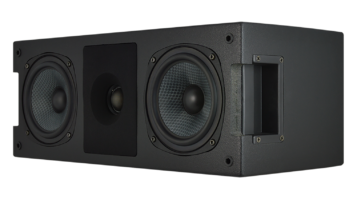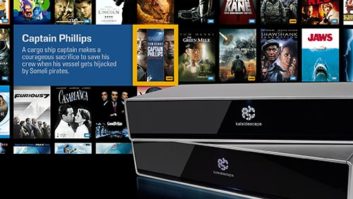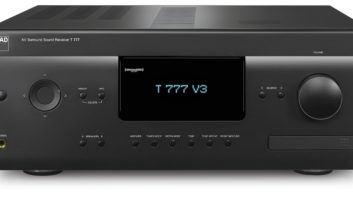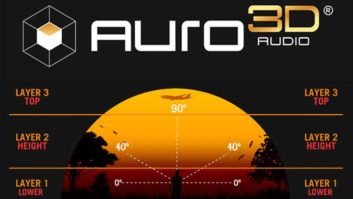The dream for many high-end listeners is to have one high-performance system capable of handling both music and movie watching. Unfortunately most AV components come up short when stripped bare of processing and surround decoding and are tasked with replicating a pure, two-channel stereo signal. For the company’s new flagship preamp/processor, VP and general manager, Kevin Zarow, told me Marantz returned to its musical roots, and looked at what they were doing in their reference two-channel systems.
The result is the AV8802a, a massive evolutionary step forward and near complete rethink over the company’s previous flagship, AV8801. For the past three years, I have been beyond satisfied with the performance of the 8801, and felt no need to upgrade, save for two things: Dolby Atmos and 4K video.

Visually, the 8802a is all but identical to the 8801 up front, retaining the company’s clean, “port hole” front-panel design with the majority of buttons and larger LCD display concealed behind a flip-down door.
The rollout of these new technologies required more processing horsepower, DSP memory, and a total HDMI overhaul to meet new full-bandwidth 2.0a and HDCP 2.2 standards. Simply upgrading the 8801 would have been cost prohibitive. This gave Marantz the opportunity to rethink its design and, for the first time, port technology and design down from the company’s vaunted Reference Series PM-11S3 integrated amplifier. The heavy, copper-plated chassis of the 8801 remains, but most of the internals have been vastly improved and reworked with the singular goal of increasing sonic quality. Some of the improvements include the latest premium 32- bit DACs, massively upgraded power supplies, and fully discrete current feedback with 13 new HDAM-SA2s. The result is a product that is significantly faster, more transparent, and more dynamic than ever before.
At $4,000, you would expect this to feel like a premium component, and the 8802a impresses from the moment it reveals itself. At 30 pounds it outweighs many amplifiers and just exudes premium build quality. Turn it over and you’ll get a glimpse of the gorgeous copper chassis. The connections are gold plated, and the volume knob has a solid feel, as does the aluminum front panel.
Visually, the 8802a is all but identical to the 8801 up front, retaining the company’s clean, “port hole” front-panel design with the majority of buttons and larger LCD display concealed behind a flip-down door. Turn it around, however, and the designers’ reworked connections become apparent. The 13.2 XLR connections are now all neatly arrayed along the bottom, an additional HDMI connection has been added (bringing the total to eight), and there are two antennas for Wi-Fi and Bluetooth. The 8801’s four-port network switch has been eliminated both to reduce space and any potential noise. The 8802a retains both the XLR and MM phono inputs, four digital inputs (two each optical and coax), six analog inputs, a 7.1-channel analog input, zone 2/3 outputs, and 3×2 component video. Connection wise, you will be exceptionally hard pressed to ever tax the 8802a.
On the control front, the system is Crestron Connect and Control4 certified and employs SDDP, making it a snap to add to a system. The 8802a also retains both an RS-232 serial connection and rear-panel IR input for more basic setups and two independent 12-volt trigger outputs. Marantz also offers a free iOS and Android app.
Also of note, the 8802a is ISF certified for video calibrators, including ISF Day and Night modes, and can upscale video to 4K/60. It retains Audyssey’s Platinum suite with MultEQ XT32 processing and is pro-calibration enabled. On the streaming front, it supports internet radio, Pandora and Sirius/XM natively, is Spotify Connect enabled, and supports Apple’s AirPlay. In addition to playing FLAC files at up to 192/24 resolution, the 8802a also handles DSD files up to 2.8 MHz.
Along with the 8802a, I added speakers and amplification to accommodate a full 7.2.4 Atmos speaker layout, including two Marantz MM-8077 7×150-watt amplifiers with all channels connected via XLR cabling. While the 8802a has 13-channel outputs (front width outputs can be used with Audyssey DSX), it can only process 11 channels simultaneously. The 8802a supports a variety of speaker layouts and connections including Atmos 5.1.2, to 9.1.2, to 7.1.4. The 8802a will support DTS:X via a free software update when it becomes available, expected in Q1. Also fairly unique is the 8802a’s ability to support Auro-3D processing via a $199 upgrade. (Currently Only Denon and Marantz offer Auro processing for under $11,000.)
Once I’d completed installation, I sat back to listen to some two-channel music to (borrowing from Clint Eastwood in Firefox) “see what this thing can do.” The first thing I noticed was that the sound had a much more open, airy quality, with incredible width and depth. The noise floor is so low that everything seems to have more space around it, making sounds more defined and resolved. While everything benefits, it’s the delicate instrumentation that really stands out; those soft brush strokes, the decay of cymbal strikes, the soft touch of piano keys, the pluck of a standing bass. You can hear the individual notes from instruments trail off and fade into nothing. Female jazz vocalists like Kelly Flint (from Dave’s True Story), Louise Rogers, and Diana Krall just breathe into the room, their voices given kid glove treatment by the 8802a’s processing.
Time and again I’m convinced the system has actually slipped out of two-channel into a surround decoding mode because the stereo image has such a phenomenally well-placed phantom center, with instrumentation clearly placed across the front of the room and dialog locked into the center–or noticeably just slightly off-center depending on the recording. Some songs, like the end of “Fun” from Coldplay’s new A Head Full of Dreams actually produce sounds with such incredible width that I’d swear were coming from my side surround channels. The imaging that the 8802a produces is really nothing short of phenomenal. More than once I’ve gotten off the couch and put my ear next to the center speaker and flipped down the front panel button to ensure it actually said “Stereo.”
Performance on movies and TV is no less impressive, and while you’d expect Atmos encoded Blu-rays would sound terrific–and they do–I’m actually more impressed with how it handles regular, non-Atmos signals. I’ve taken to watching everything with the Dolby Surround Upmixer engaged, which takes any material from 2-7.1 and plays it through the entire 7.1.4 system. The 8802a extracts the perfect signals to route to the ceiling speakers, making for a far more enveloping presentation, without ever sounding artificial or reducing dialog intelligibility.
I don’t want to sell the 8801 short because it was a terrific component that set a performance benchmark in my system, but the 8802a delivers next-level performance in every sonic regard. There aren’t many options in the sub-$5,000 separates market, and the 8802a has definitely established itself as the king of the hill.
201.762.6500
us.marantz.com
Kudos
Terrific build quality; incredibly feature rich; handles all 3D audio formats; reference quality sound
Concerns
None
Product Specs
► 13.2-channel AV pre-amp/processor
► Supports Dolby Atmos, DTS:X (coming via free update), Auro-3D (with paid upgrade)
► Audyssey Platinum Suite (MultEQ XT32 processing, Sub EQ HT for dual subwoofer setups, Pro Calibration ready)
► 8 full-bandwidth HDMI 2.0a/HDCP 2.2 inputs; 3 HDMI outputs, including dual main-zone and discreet second zone
► High-resolution 192 kHz/32-bit DACs on all channels
► Wi-Fi and Bluetooth, Apple AirPlay
► Balanced XLR and gold plated unbalanced RCA jacks for all 13.2 audio outputs
► Dimensions: 7.3 x 17.3 x 15.3-inches (HxWxD); Weight 30 pounds







